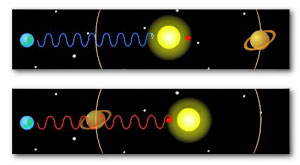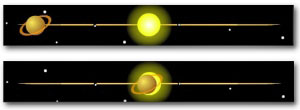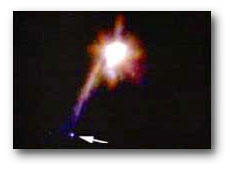|

from
AereeAndBen'sAstronomyLab Website
In recent years,
over fifty extrasolar
planets
have been detected
via various methods
which we'll discuss
in turn.
What is an
Extrasolar Planet?
It refers to a planet that resides outside our solar system. Now,
this might seem pretty obvious, but some of the extra-solar planets
that have been detected have been extremely large; planets that have
been many times the mass of Jupiter have been detected. When you get
that large, they really cease to be planets and are rather low-mass
brown dwarfs, or 'failed stars' that are too small to undergo
hydrogen fusion and emit their own light. Generally speaking,
planets cannot be more than ten times the size of Jupiter or else
they are too large. As always though, the debate does not end there
since we aren't really sure how brown dwarfs are even formed.
The main problem posed with detecting
extra-solar planets is that compared to the brightness of the stars
they are orbiting, they are extremely dim; planets cannot give off
their own light, and so we can only 'see' planets by light that is
reflected off them from their stars. With traditional astronomy, it
is at the moment impossible to detect these planets since their
light is far outshone by the stars they orbit around. Therefore, it
has been necessary to use other techniques.
Various
Detection Techniques
I.
Astrometrics
Instead of trying to look at the planet directly, so
far all our efforts have been concentrated on looking at stars
to see if we can infer the presence of a planet by the behavior
of the star. By this, we mean that we look for signs in the
movement of stars that suggest that a planet might be
responsible for.
To do this, we have to determine how a star
should be moving in the first place - if we don't know this,
then we don't know if what we're seeing are signs of a planet,
or the star's normal movement. Astrometry is the branch of
astronomy that can determine the 'normal' movement of a star
based on its location in reference to other nearby stars.
II.
Wobble-Detection
Once we know how a particular star 'should' be
moving, we can actually look at it and find out how it is moving
in real life. If a star has a large planet orbiting around it,
the gravity of that planet will influence the movement of the
star - the influence will be very small, but detectable. This
influence will result in the star 'wobbling' around the path it
'should' be moving on - which is why we call it
'wobble-detection' (believe it or not, we didn't make this term
up - it's regularly used to describe the technique in scientific
journals).
As yet, only large planets can be
wobble-detected since only they exert a large enough gravity to
make a large, detectable wobble in the path of their stars. As
astrometric and astronomy techniques improve, it is possible
that smaller and smaller wobbles - and thus planets - can be
detected in this way.
III. Radial Velocity
Radial velocity relies on the very foundation of
modern astronomy - redshift. The way redshift works is that when
light from an object (generally from a star) appears to be
shifted to the red part of the spectrum (hence, redshift), we
can tell that the object is moving away from us. When the object
is moving towards us, the light is shifted towards the blue part
of the spectrum - it is blueshifted. By carefully examining the
light emitted by the star (examining the 'spectrographic shift'
of the star) we can work out whether the star is moving away
from us or towards us.
|
As the star moves away from the observer - the Earth - due to
the influence of the gravity of the planet that is orbiting
around it, the light from the star is redshifted.
Conversely, as
the star moves towards the observer, its light is blueshifted.
This regular change in spectrographic shift of the light from
the star would indicate to scientists that the star had a
planet. |
 |
When a planet orbits around a star, it will slightly alter the
radial velocity of that star - in other words, it will also
create a wobble in the movement of the star. This time however,
we don't look at the movement of the star, but we look at the
light from the star. If there is a planet orbiting around a
star, the star will appear to be moving towards us, then away
from us, then towards us and so on, because it is wobbling along
its path. If the star had no planets, it would move smoothly -
there would be no changes in its radial velocity.
This means that by looking at the
spectrographic shift of the star to see if it is redshifting,
then blueshifting, then redshifting (and so on) we can determine
if it has any planets orbiting around it. This technique is also
called the Doppler technique (related to the Doppler effect,
which causes sounds to change pitch as their source moves
towards, then away from your position). Again, this change in
the spectrographic profile of a star is very hard to detect and
only very large planets, or planets very close to the star, have
been detected using radial velocity.
So far, the vast majority of
extra-solar planets have been discovered using radial velocity.
Among others, the AFOE (Advanced Fiber Optic Echelle) project at
Harvard and the Observatoire de Haute-Provence have used radial
velocity to detect extra-solar planets.
IV. Transit Photometry
On the rare occasions when the plane of a star and
its planet are exactly in line with the direction we are
looking, we can detect a planet by transit photometry. When a
planet passes in front of a star, the star's brightness will
drop slightly. As the planet orbits around the star, this drop
in brightness will occur with every orbit of the planet. This
regular dimming allows us to detect the planet.
|
 |
If you are viewing a solar system from the edge on (i.e.
parallel to the plane of the system) then as a planet passes in
front of the star, the star's brightness will momentarily drop.
|
Although it might seem very unlikely that we'd be looking in
just the right direction for transit photometry to work,
scientists from the NASA Ames center used the Vulcan photometer
at the Lick Observatory to detect a planet orbiting the star
HD209458 in December 1999 with transit photometry. The
scientists were able to narrow the odds against them by
monitoring roughly 6000 stars every night.
V. Direct Imaging
Direct imaging means detecting planets by looking for
them directly. As mentioned earlier, this is extremely difficult
to do with the telescopes we have now since the planets are so
dim. However, with the development of increasingly large and
sophisticated telescopes that use techniques such as adaptive
optics, it will be possible to at first detect large planets,
then progressively smaller planets. Projects such as the NASA
Terrestrial Planet Finder and the ESA Darwin space telescopes
will, along with other techniques, use direct imaging.
VI. Coronography
All stars emit a corona of light around them, and
this can be detected using telescopes. If a planet was orbiting
a star, it would block out part of the star's corona - and so
you could detect a planet by studying the corona of a star. The
French COROT telescope aims to do just that.
Hubble
Telescope Unveils First 'Extrasolar Planet'?
Article by Nicolle
Charbonneau (May 28, 1998)
|

click image
to enlarge
[Figure] TMR-1C
is the first direct evidence of a planet beyond our solar system
|
While peering into a dark, dusty
region of space in the constellation of Taurus, a team of
astronomers in Pasadena, California made an extraordinary
discovery: the first direct evidence of what may be a planet
beyond our solar system. The small group of researchers were
using the Hubble Space Telescope to study a young binary star
system -- two stars very close together and orbiting each other
-- when they stumbled across what astronomers are calling "a
landmark in our quest to understand our origins," a discovery of
"historic significance", and "a watershed event."
For Dr. Susan Terebey and her team
from the Extrasolar Research Corporation, the excitement of this
discovery was overwhelming. "It all fell into place," she told
reporters at a press conference on Thursday, describing the
moment of discovery.
"That was really an
indescribable experience. Our team has just been walking on
air."
The object, with the rather
unglamorous name of
TMR-1C, has a mass
two to three times that of Jupiter and is located about 450 light-years from Earth. It
appears that the planet originally was in orbit around one of
the binary stars, but because of the instability of the star
system, the planet eventually gained enough momentum that it was
thrown out of its orbit.

[Figures from left to right]
1) Dr. Susan Terebey
heads up the team at Extrasolar Research Corporation, which
discovered the object while using the Hubble Space
Telescope;
2) Terebey and her team
speculate that the object was ejected from its orbit around
the binary stars between 500-1000 years ago;
3) Because of dust and
gases in that region of space, the binary star system and
its planet are visible only with an infrared telescope;
4) The large number of
binary stars in our galaxy could mean the discovery of other
planets in the near future
As it traveled away from its binary
parents, it left a long filament of matter, which Terebey calls
a "lightpipe", because it acts like a tunnel for light to travel
through space. Terebey and her team used Hubble's infrared
telescope to peer through the gas and dust clouds that darken
that region of space. NASA released the images Thurday at 1:00
pm ET, revealing a planet that is 10,000 times less bright than
our sun, but bright enough to indicate that it's a very young
object. In fact, Terebey and her team speculate that the object
may be only 200,000-300,000 years old; that would make it
incredibly young, since gas planets usually form over a period
of 11 million years.
The object's young age has
scientists speculating about a new method of planetary formation
called the one-step method, in which planets to form in hundreds
of thousands, rather than millions of years. And since the vast
majority of stars in the vicinity of Earth are binary star
systems, this discovery has also heightened speculation about
the discovery of other planets in the next five to twenty years.
While scientists at NASA are reluctant to make any guesses, they
admit that this is a step towards finding extra-solar
terrestrial planets like Earth which may have developed in
conjunction with a gas giant.
The next step for scientists
involves confirming that it is a planet and not a star shining
from light-years beyond the binary system, or a
brown dwarf
star--a rare celestial object that forms like a star but
doesn't shine like one. This work will be done with the HST,
Hawaii's Keck Observatory, and eventually with the Next
Generation Space Telescope and the Space Inferometry Mission,
which will provide much higher resolution pictures.
|




